WOW! - Sapa, Vietnam

Harmonie
Don and Anne Myers
Sun 15 May 2011 20:45
|
22:20.504N 103:50.653E
April 28, 2011 - April 30, 2011
Wow. What a fantastic place. We enjoyed Hanoi and
its craziness (and went back for more after Sapa, as you'll see), but Sapa took
our opinion of Vietnam from wow to WOW! Vietnam is now permanently placed
on our top ten countries visited list - right up there with New Zealand, Vanuatu
and Indonesia.
Getting to Sapa was definitely part of the adventure. It
started with the night train from Hanoi to Lao Cai. Driving to Sapa is not
recommended as the roads are said to be in very poor condition. There is a
day train to Sapa, but Don's research on the web revealed the day train would be
fine as long as you didn't mind sitting eight hours on a hard seat in a lurching
train cabin with poor ventilation.
At the start of our journey north, there was a little bit of
travel trepidation after our taxi dropped us outside the Hanoi train
station. Darkness descended, it started to rain, and we stared at the
milling mass of people, most of who were at least two feet shorter than Don,
and wondered where exactly we were supposed to go. A tense ten
minutes later and through the use of broken English and hand signals, we
got our train coupons turned into tickets and were corralled with other, equally
bewildered-looking tourists, to board the 'tourist train'. The Charming II
Hotel in Hanoi arranged our train tickets for us and we opted for the cheaper
4-person cabin rather than the more private 2-person. Specifically, we
were booked in a 4-berth 'soft sleeper' cabin on one of the many tourist
'trains' (really tourist cars, rather than separate tourist trains). We
shuffled through the misty-rain with the other tourists to our car and squeezed
ourselves and our luggage into our cabin. Our cabin-mates showed up
shortly thereafter and we arranged ourselves so the luggage was stored above and
each couple was perched on the two lower berths facing each other with knees
nearly touching. We spent the next several hours getting to know our
cabin-mates, a very friendly younger couple from Paris who spoke excellent
English (oh how we English speakers are spoiled!). It was a very pleasant
time and we ended up running into them several times throughout our stay in
Sapa and on the train back to Hanoi (unfortunately not the same cabin
though). At about 9:30pm, the four of us turned in. After
climbing into the upper berth, I stretched out on the concrete-like
mattress (soft sleeper?) with Don below me in the lower berth, and the
French couple directly across from us. All was quiet until about 4:30am
when the attendant rapped on the door to announce our Lao Cai arrival
and the end of the line.
Lao Cai is on the Vietnam side of the border with
China, and in the foggy early light and misty rain,
it looked drably industrial like a bleak eastern
European train yard scene out of a WWII movie. It got
a little more surreal as we waited in one of the many tourist
mini-buses for all the tourists to sort themselves out, and we noticed budding
Vietnamese entrepreneurs canvassing the area selling Sapa maps and what
looked like mini flashlights. One woman came to the open door of our
mini-bus and shined the mini flashlight against the back of the seat
in front of Don. There, in living color, was the image of a very
buxom topless blonde woman.. "Like wife!!" cackled the woman. "You
want? I sell you cheap price." Don declined the offer, but
we did get a kick out the sales pitch. Where else but communist Vietnam
would you expect to see an old woman selling soft porn trinkets to
tourists at five in the morning?
Once all the tourists were settled, the mini-buses set off on
the 90 minute drive to Sapa through the mountains. It's good we had to
wait as long as we did because we would have missed the amazing scenery
otherwise. Later we learned from one of our guides that for safety
reasons, the tourist mini-buses do not make the Lao Cai - Sapa trip in the
dark. After experiencing the trip twice, we can see why. The
road was in better condition than we anticipated with guardrails on the side
that mattered (we learned later that the road had been upgraded using funds
gained from the tourist trade). The road was quite narrow
though, requiring the driver to give a warning horn toot before entering each
of the zillions of sharp curves. We were assured that the
drivers could safely complete the trip in their sleep, which according the
Maloney's is really good because they did the same trip in heavy fog with
zero visibility. Needless to say, they were a little more breathless when
describing the trip than we are (and rightly so). Along the way we got our
first views of rice paddy terraces cut at perfect angles down the
sides of mountains leading to small villages nestled in river
valleys. The road winds high through the mountains, so our views were
spectacular and sometimes straight down. The guardrail was
comforting.
Sapa is a tourist town, but for very good
reason. It sits on a high plateau overlooking a huge valley filled
with ethnic minority villages and rice paddy terraces. Across the valley
is Vietnam's highest mountain peak, Fansipan, at about 9,500 ft. Hard
core trekkers come here to hike the endless trails. Because most of the
mountains are cleared for rice and other crop production, the hiking trail
opportunities are many as long as you don't mind a bit of mud. Never
having been described as hard core anything, we came to Sapa for the
scenery, cool weather, walking trails and an opportunity to get to know the
people. We got what we came for and then some. Below are
pictures.
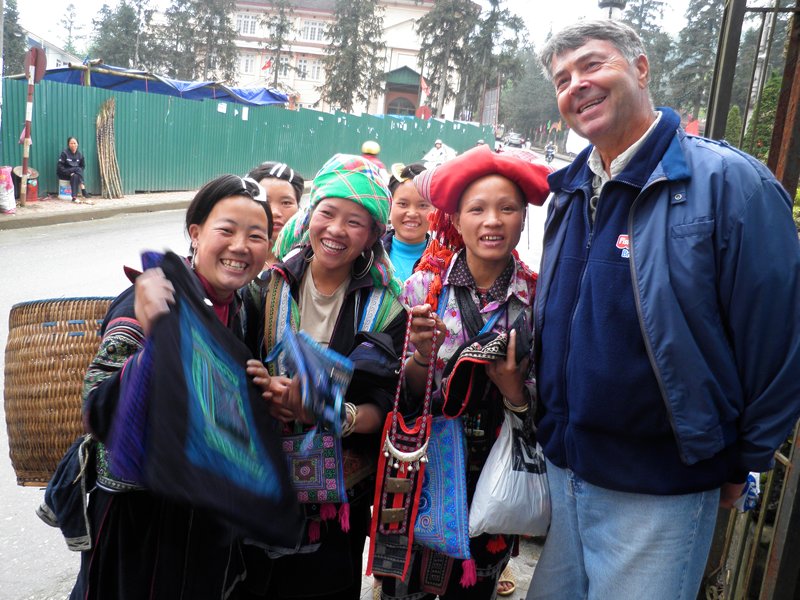 "Buy from me! Buy from me!"
As soon as we exited our hotel after getting settled in and
taking a short nap, we were accosted by the hill tribe women. Accosted is
probably too harsh a word as these women may be extraordinarily persistent, but
at the same time they are extremely friendly. Unlike some tourists
who were exceedingly rude to the women, we didn't find them annoying.
Fifteen years ago, before tourism came to Sapa, all the ethnic minorities tended
their fields, raised their kids and traded goods at the weekend markets.
There was no need for money. They grew their own food, made their own
clothes and traded for anything else they needed. Today they still grow
their own food and make some of their own clothes, but tourist money is so
alluring, many women spend two or three days a week combing the streets of
Sapa for tourists willing to spend a few hundred thousand dong ($5-$10) on
their embroidered goods.
When we first left the hotel, we were greeted by three Black
Hmong women who walked with us for at least an hour through the town, then
waited patiently outside while we had lunch at a restaurant. When we came
out of the restaurant, we decided enough was enough - we would buy
something. As soon as we started haggling, it was like a red light went on
throughout the town, and suddenly we were surrounded by a crowd of Black Hmong,
Red Dao and Giay women all wanting to see how much we would overpay. Once
the transaction was finished we were bombarded with a chorus of "Buy from
me! Buy from me! You buy from her, but not from me!" Above is
a photo of the five most persistent of the group. Starting from the left
is a Black Hmong, Giay, Red Dao and two more Black Hmong women in the
back. They surrounded us as we walked back through town, waiting patiently
outside stores. In the end we didn't buy anything more, but they
were good natured about it, the Black Hmong girl on the left saying, "I will
follow you everywhere until you buy from me!" She didn't, so we never
did.
In between their selling spiels, it was really interesting to
talk to these women and girls. Their English was surprisingly good (all
learned through contact with tourists). The usual information was
exchanged: name, age, marital status, number of children, number of brothers and
sisters, where we were from, what village they were from, how they spent their
time, what school their kids went to. No schools existed in the villages
until the tourist money started flowing. Before that, if village kids went
to school, they had to hike up to Sapa. Now there is a school in almost
all the villages and it sounded like most village kids attend at least through
the 8th grade, some through high school and a very few go on to university
elsewhere in Vietnam. We were glad to hear that tourist dollars were at
least doing some good. The problem with tourism is it sometimes ruins the
very thing that was attractive in the first place. Like the women spending
half their time selling embroidered fabrics (only a portion of which they sew
themselves, the rest coming from China or factories in Vietnam) instead of
tending the fields - all done in a quest for money to pay for store bought
clothes, cell phones and motorbikes. As our guide said, 'What can you
do? You can't stop progress and you can't stop the people from wanting the
things everyone else in the world already has." True, but just like in
Vanuatu and Indonesia, we hate to see 'progress' happen. It's too
much like watching an entire culture lose its innocence.
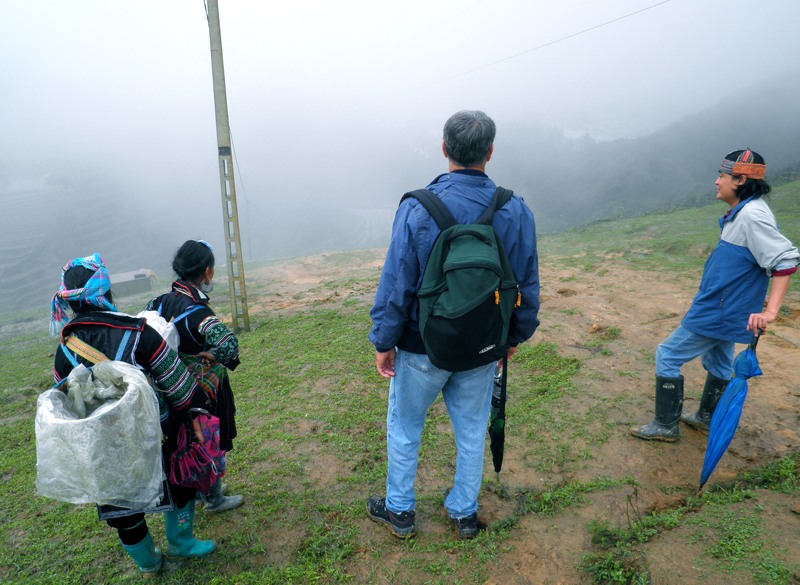 Contemplating the hike down the mountain in rain, fog and
mud.
Our second day in Sapa was spent with our private guide Danny
(right), walking from our hotel, down the steep mountainside and through the
rice paddies to several villages in the valley. With us went one Giay
woman (far left) and one Black Hmong (next left). We met the
Black Hmong woman the day before and when we learned what village she was from,
we told her we were going to visit there the next day. When we parted ways
and she said she would see us tomorrow, we had no idea she would be waiting
outside our hotel the next morning for the trek to her village. Yup, she
went the whole way with us, holding our hands during the most difficult parts
(as did Danny and the Giay woman), and waiting patiently at the end for us to
buy something from her (we did).
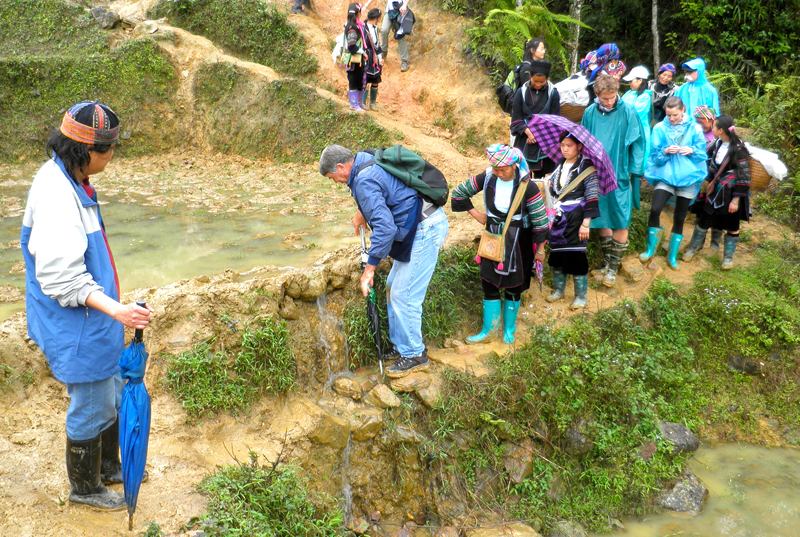 Don holding up the line.
Notice the foot wear. The advice we were given regarding
hiking in Sapa was, "Wear rubber boots, all the locals do. You'll need
them for the mud." We tried, but the stores in Sapa don't offer
rubber boots in Don's big size. Remember, the Vietnamese are
small. We've been feeling large ever since visiting Indonesia,
but I don't think we've ever felt quite as giant as we did in Vietnam, so
it's no surprise size 11 1/2 rubber boots were not available.
Instead, Don bought the one pair of knock-off North Face hiking shoes that fit
him (Sapa is the world capital of knock-off North Face clothing and
shoes). Unfortunately, hiking shoe grip is not equivalent to rubber
boot grip in rice paddy mud, therefore, Don took a bit of a sit-down
spill. You can't see it in this picture, but most of his right side is
covered in muddy goop. The point of all this is to explain why Don is
acting so cautious and holding up the hiker line in this photo. For most
of our day, we were on our own with Danny and our two women escorts, but
occasionally we ran into, or rather held up, other tour groups. We blame
the shoes.
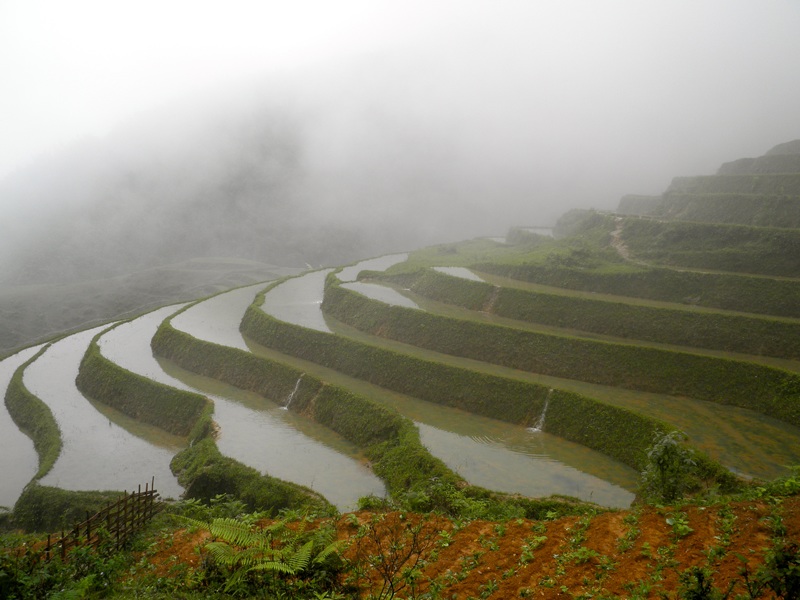 Every fifteen minutes or so the mist lifted enough
to reveal a gorgeous view like this one.
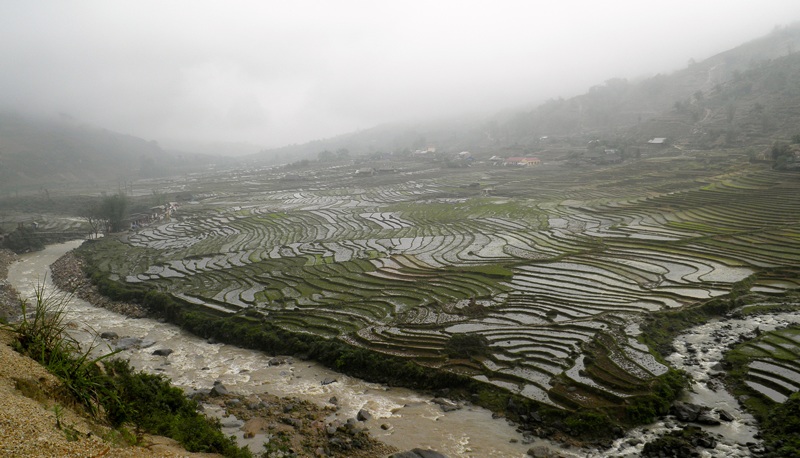 And this one.
 And this one showing hill tribe villages in the
valley.
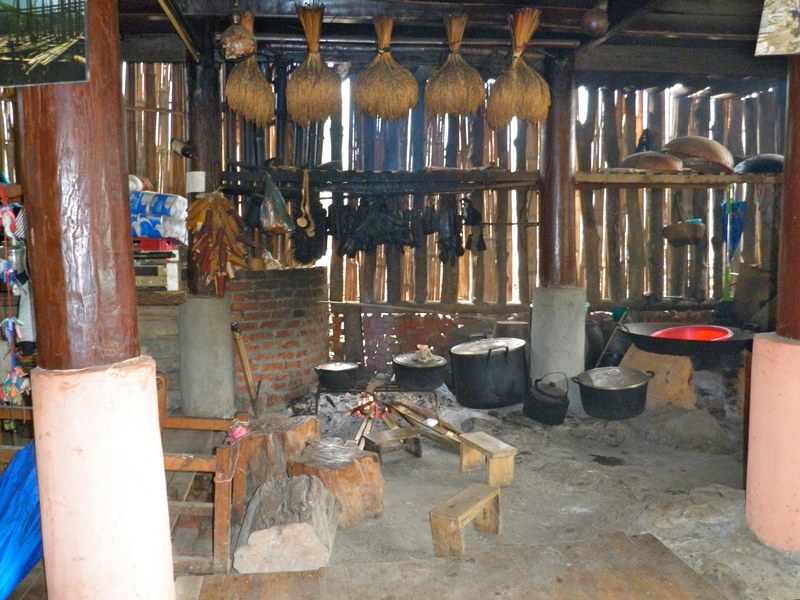 Lunch stop.
After reaching the valley floor, we walked through three
villages, stopping in the last one for lunch. Between the second and third
village, two tiny older women declared themselves to be our tour guides (Danny
found this to be amusing), picked up a hand from each of us and ducked under our
umbrellas for cover. By this time, our previous women escorts had returned
to their villages. To get to the last village, we were guided to
a shortcut through a rice paddy. Balancing on the terrace
edge, Don and I held an umbrella in one hand while the ladies'
iron grip held our other hand captive. At one point, Don had a 3 1/2 ft
tall lady on each side, both squeezing one of his hands. It would
have made a great picture if I hadn't been so busy trying not to fall
into a mud hole at the time.
We had one of our best Vietnamese meals that day, part of
which was cooked in the kitchen pictured above. It was a five course
affair including soup, spring rolls, some kind of sizzling pork dish, shrimp,
rice and fresh fruit. We've decided Vietnamese is the best of the
Southeast Asian cuisines we've tasted so far - everything is fresh, tasty,
not too spicy and more diverse than other local cuisines.
After lunch we took the wimpy way back to town in a SUV. We
spent the rest of that misty day watching the royal wedding on CNN.
Ok, I admit, it was me glued to the TV for 3 hours watching British ladies in
hats while Don napped.
 Not a bad view.
We spent our third and last day in Sapa doing the Cat Cat
walk. Cat Cat is a Black Hmong village in the valley connected to Sapa on
the plateau by a road (as seen in this photo) and
a stone-paved walking path. No guide is required for this walk,
so we meandered all the way down and up on our own under a sunny sky with no
escorts. In general, the weather in Sapa was a huge relief for us.
Even the rainy day. We were able to wear jeans and jackets for the first
time since....since we were home - but it was winter at home, so not really all
that pleasant. In Sapa we reveled in the cool temperatures, lower humidity
and less-brutal sun. Ahhh.....no sweating! Makes us yearn for summer
in upstate NY.
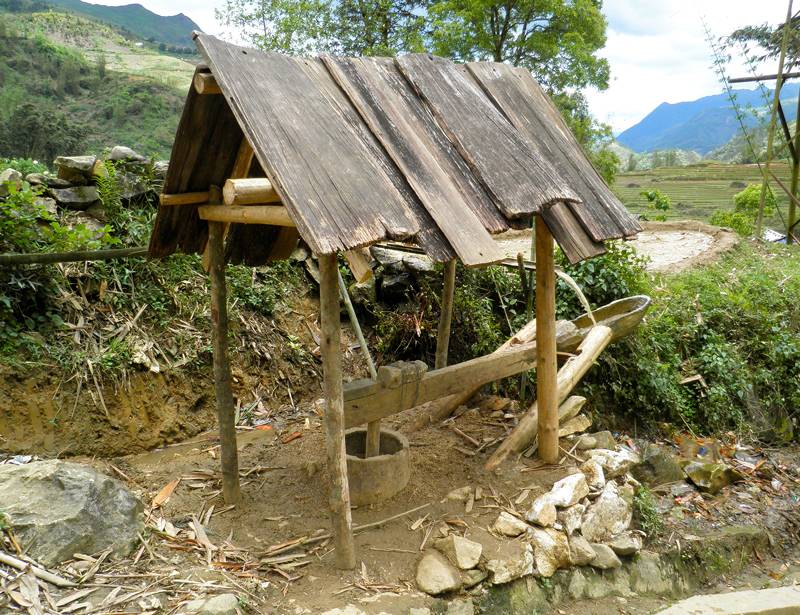 One of several water powered rice pounding contraptions we saw
along the Cat Cat walk. Water fills the scoop causing the mallet at the
end of the wood shaft to rise. Then the water spills out of the scoop,
causing the mallet to strike the rice in the wood bucket half-buried in the
ground. Since we didn't have a guide we couldn't ask how many
days it takes to pound rice into flour using this method. Our guess is
quite a few.
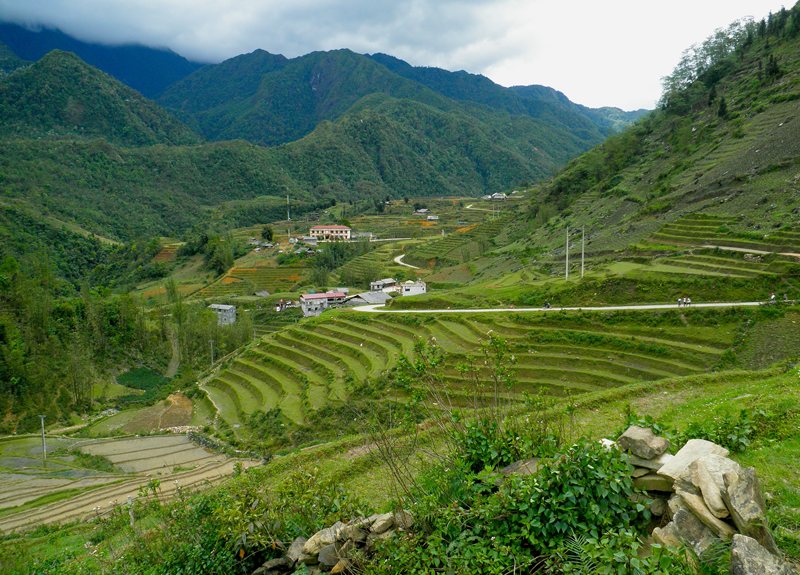 Cat Cat village. The large building in the center is one
of the schools presumably built with tourism dollars. And dollars they
mostly are. Most establishments (and the hill tribe women) are more than
happy to accept US dollars in place of Vietnamese dong.
 A happy trade.
While waiting for our bus back to Lao Cai for the night train
to Hanoi, we had a few hours to wander the streets of Sapa. We were hoping
to get rid of the rubber boots I bought for hiking because while we do have sea
boots (basically rubber boots) on board, we haven't worn them since Lake
Ontario, and certainly didn't need another pair. We ran into
this woman on the street outside our hotel and before we had a chance to
offer them up, she said she would really like a pair of boots. We agreed
on a trade - one pair of slightly used turquoise rubber boots for a hand
embroidered turquoise wallet. A good trade. You can see in this
photo why we feel like giants around the Vietnamese.
Liberation Day
It wasn't until we were in the hotel lobby preparing for the
Cat Cat walk that we realized it was a holiday. The hotel concierge seemed
unusually animated while encouraging us to take a bus tour away from Sapa for
the day. We didn't go for the tour, opting to wander on our own. The
atmosphere in town seemed to indicate something was going on. We finally
broke out the guide book and looked up Vietnamese public holidays. While I
had the book open Don joked that it was probably the day they celebrate the fall
of Saigon. It was. We laughed like crazy. Who would have
thought thirty-six years ago that we'd be in the heart of North Vietnam on the
anniversary of the fall of Saigon? Vietnam has so few public holidays
(only 5), you'd have thought the trip planner (me) would have paid
more attention to such things. Oops. No one seemed to mind
though. Sapa was hopping. There was a huge street market and much
ado going on in the town square. We walked through the mass
of celebrating Vietnamese several times and no one took
notice. Based on our experience, we would agree that the Vietnamese have
no desire to look back. They are interested only in the
future.
These sentiments were later confirmed when we dropped by our
guide Danny's tiny cafe/art gallery (selling his own paintings). As
we chatted, one of his other clients, a German, stopped by for a beer and a
chat. So there we were, two Americans, a German and a North Vietnamese in
a cafe discussing war. It sounds like the beginning of a joke, doesn't
it? Two Americans, one German and a North Vietnamese walk into a
bar.... Anyway, it was fascinating listening to Danny relate war
stories told to him by his father. His father was sent to East Germany in
the 1960's for five years of training. Upon his return to Vietnam, he was
given a leadership position and sent off to the front. At one point, he
and some of his troops took cover from a US bombing campaign in a
small Viet Cong tunnel complex. They remained there for nearly a
month, unable to leave due to the continuous barrage. They ran out of food
and Danny's father says they survived on gun powder. They ate
the gun powder from various forms of ordinance found in the tunnels, and
lived. Amazing.
A second favorite war story of Danny's went like this.
Toward the end of the war, Danny's father and his unit were entrenched on one
side of a river, with Americans on the opposite side. The fighting
went on day after day with neither side making progress other than to
kill or wound some of their adversaries across the river. One day,
Danny's father decided enough was enough and stripped off his uniform and all
his weapons. Naked, he called out to the Americans and indicated
he planned to swim across. He did, with many of his naked troops
behind him. Once on the American side, the Vietnamese indicated they
wanted a break from fighting and that they came naked to prove they were not
armed. The Americans loved the idea, stripped down and the two sides
proceeded to play football (soccer). At the end of the day, the
two sides shook hands and the Vietnamese swam back across the river.
The next day, it was back to business.
Danny said his father was a firm believer in change for
the better - in the 1990's, he was a strong proponent of mending US/Vietnam
relations. Again, amazing given what he went through in the
war.
We had an uneventful bus and train ride back to Hanoi, this
time sharing our train cabin with a younger couple from
Minneapolis.
Next up: Hanoi Again.
Anne |